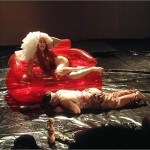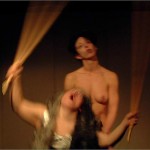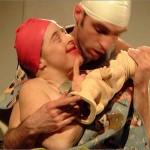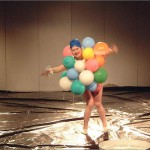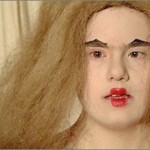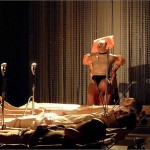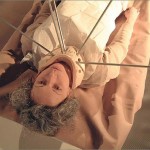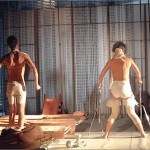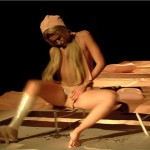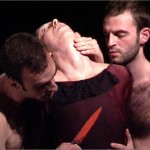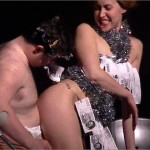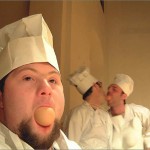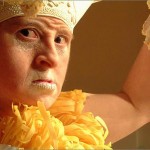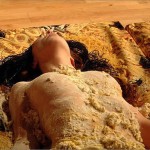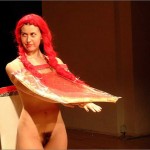
FAUST I
The dramaturgy of Faust I sinks into the first part of the definitive draft of Goethe's work. In Lenz's vision Refractions, directed by Maria Federica Maestri and Francesco Pititto, the Faustian cognitive tension – the streben – is realized in porneia – prostitute – of the body.
Faust in search of the sensitive human, of the vibration that regenerates, of sexual energy that restores youth, it strips itself of the dignity of the subject and becomes the object of physical experience.
Bodies for sale, the souls already sold, orifices witnesses of pleasure and pain, limbs and members pointed by virtue of solitary enjoyment, unaware of the guilt, innocent, children show themselves on the screen of the theater fairy tale.
Faust is here, limping on the verge of suicide. Abandoned the god of reason, the old is ready to melt into everything, to proclaim dementia as the queen of emotion. The body encouraged to abandon the old moral rule relaxes with the muscle stretched out to the humidity of loving nostalgia.
The faithful Margherita dies and dies of love as always, in his suit of banknotes. He strips himself of his suffering and dances the dances of dishonor, donating his money to the merchant public. He dances to the rhythm of Portuguese music and auctions off his body and voice in the putrid cellar.
Bad poets, dry and long arms drunk with life, locked up in lumbar cellars they sing at the top of their lungs about the evil of the goat. Natures without cerebral motion, dancers ugly shadows of the night without stars. Somewhere over the rainbow, acoustic toposities listen to solitary pleasure. All squeezed into a large basin overflowing with corks flooded with piss and wine. It foams in the air by twirling the hanging wooden shaft of the fleshy stick. Faust, a female body still blind to sex wears a blindfold that obscures its sight.
Accompanied in this sour cellar by Mephisto, shamelessly delighted by hot tongues, searches with his hands for the natural key to male bodies while the blindfold falls and the intense blue of his amazed eyes rises. It burns, it burns, the morality of godless beasts is on fire. “Ah, Faust, do you ignore it or do you know the hole you want to plug with wax? Oh illusion, remove the blindfold from their closed eyes. And don't forget how the devil jokes!”
In the scene of shining curtains, yarns and beads, the sun loungers reinterpreted by the action painting of Maria Federica Maestri, they host showcase bodies and legs together with natural bodies, obscene extensions of forbidden desires.
The kitchen is the fragrant place where Faust finds his youth again, to the touch of a witch without sex and without a fairy tale, moistened by the ointments of his saliva, she sees herself in the mirror which reveals her pubic beauty. In the orgiastic Walpurgis Night witches' gathering and festival, Faust undergoes the ritual of initiation into male life: with large scissors Mephisto cuts his long hair and makes him endowed with the power of the phallus. On this night, dressed in shiny paint, the sex partisans mate via their bottoms, twilights of the body, filthy holes loved only in the brevity of fecal discharge: it is the night in which the losers of modesty dominate, who together witness the only tied and foul-mouthed kiss between Faust and Margherita.
The will-o'-the-wisp guides them between cliffs of ideals and landslides of dreams. Scum flows, humanity is on its last legs. Without enchantment the man curses the leeches attached to his bottom. In the dance of the Last Judgment no one tolerates the miserable vestal, no one takes pity on the pale and lifeless little girl, delight and pang resembles the good Margherita. Bad Star of Poverty does not serve the purpose of comedy.
As a sound blanket of sinuous seductions, the musical score by Adriano Engelbrecht and Andrea Azzali innervates the dramaturgical scansion of the scenes by building the indispensable “fundamental tone” (sound basis) of theatrical action. An overture of thematic fragments announces Faust's entire cognitive journey: one's resurrection from the music of the loving encounter in the garden, the youthful metamorphosis of the aged body in witchcraft cuisines with uninterrupted electronic variations, Margherita's bold song projected into the infantile sound of timbral filters to arrive at the absolute silence of passion and desire in Walpurgis Night. Only Oberon's entrance, Puck e Ariel, Shakespearean rib of the theater within the theatre, leads astray and ends the Faustian path in a sort of whirlwind “dance”, rhythmic elaboration of dances with an ancient flavor.
Director's notes on the staging of FAUST I by Francesco Pititto
Developments and differences from the Cellar and Walpurgis Night presented in the form of studies. Scenic states achieved. Presence of the Red-Haired Child by the Brothers Grimm in the Cellar.
Our Ur continues to push bodies and voices of the experience forward. Urfaust is an integral part of our Faust I, not the premise. There is no life between one work and another but an uninterrupted time of artistic growth. The characters are not revived and developed but suddenly fall into the new scenes. Like angels: This is not how Faust begins?
Margrete dances in the cellar and splashes wine in the faces of the patrons. Faust enters with a red cloak and a blindfold that makes him blind.
Philemon and Baucides are no longer there and perhaps they will return in Faust 2 but the saga continues with new entries: Valentin, the customers of the cellar, the Witch, the Monkeys, Lilith, Oberon, Puck directly from our Dream from a few years ago, Ariel from “Storm” and not from Faust.
After A Midsummer Night's Dream, Romeo and Juliet, Ur-Hamlet, Richard II, Him-light, Macbeth, Shakespeare again in our streben?
Faust discovers the male sexes by discovering the diversity of genders. The blindfold falls and his blue eyes open wide to reality.
Some characters such as Marthe and Wagner appropriate characters from their most important interlocutors. They almost replace their superiors.
The beginning is with the monologue on Faust's desire for death. A ringing of bells intervenes to interrupt the experience. The arrival of the angel/devil diverts the drive. Ecco, a little dog over there. What breed is he?? A Poodle.
Marthe fertilizes the earth with Margrete's words above the buried Faust and Margrete. The loving dialogue is taken by Marthe and transformed by her into an act of love with the earth (like Mephisto's reproach to Faust in the Night of Urfaust).
Poped out of the ground, Margaret: What a heavy air, what a smell of sex here!
Valentin is already present among the patrons of the Auerbach winery. He's the one who sang at the top of his lungs and spat corks in the cellar presented at the Festival.
Valentin's monologue through his sister Margrete. Little Gretchen warns, by blood attunement, brother's feeling and speaks on his behalf. Who knows more about their destiny than her?
The Witch's kitchen – between myth and magic (Elena, Helena, Romantic Iphigenia and tragic Iphigenia, Lilith, the Witch) – and Faust in search of youth and physical beauty (transformation carried out by the witch with flour and eggs) they open up new landscapes. Entrance of the chefs-mammons with decorations made of neoclassical bodies. Competition of bodies between rejuvenated Faust and Margrete dressed in pizza. A fake hand joins the two real hands. There is no hope of union, we can already feel the escape and abandonment.
The Walpurgis Night Dream (our Midsummer Night's Dream already contained the fragment of Faust's Walpurgis Night, Empusa and the witches).
Puck e Ariel (anticipation for the “Storm”?)
The Dedication at the end as a contemporary musical score of noises, sounds, silences, voices, ecc. The reference to John Cage's musical research should be direct.
FAUST I
dal Faust di Wolfgang Goethe
translation and dramaturgy || Francesco Pititto
regia || Maria Federica Masters | Francesco Pititto
musica || Adrian Engelbrecht | Andrew Azzali
scene | costumes | you decorate | rouge || Maria Federica Masters
interpreters || Adrian Engelbrecht | Matthias Giacopinelli | Sara Monferdini | Elisa Orlandini | Alessandro Sciarroni | Sandra Soncini | Barbara Voghera
production || Lenz Refractions
first || Dream space, Parma, 2001
duration || 120 minutes with 15 interval minutes








